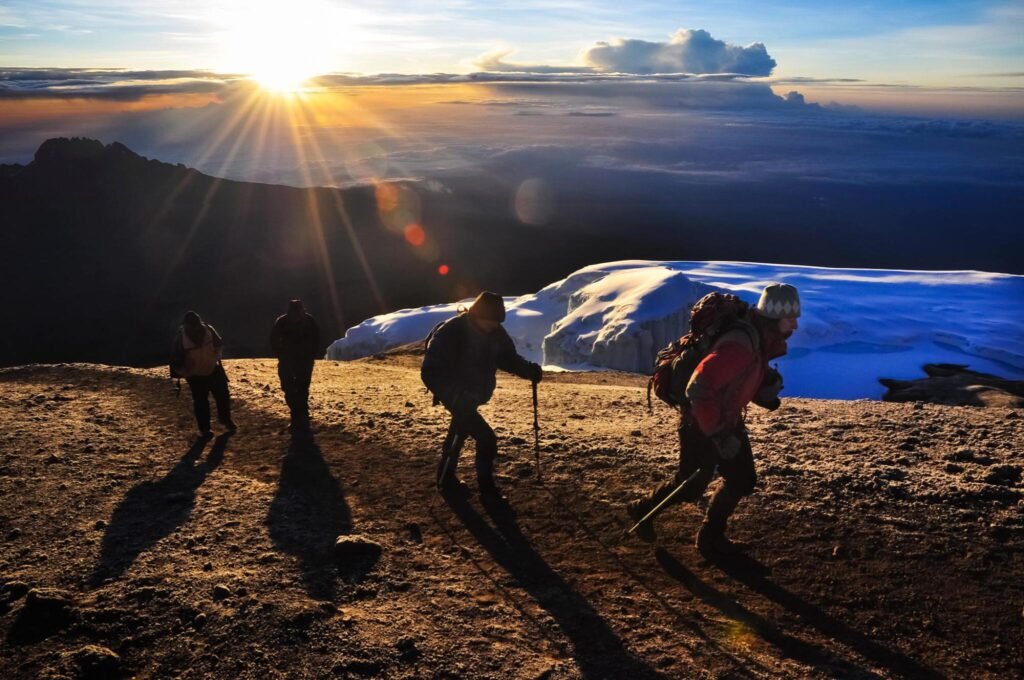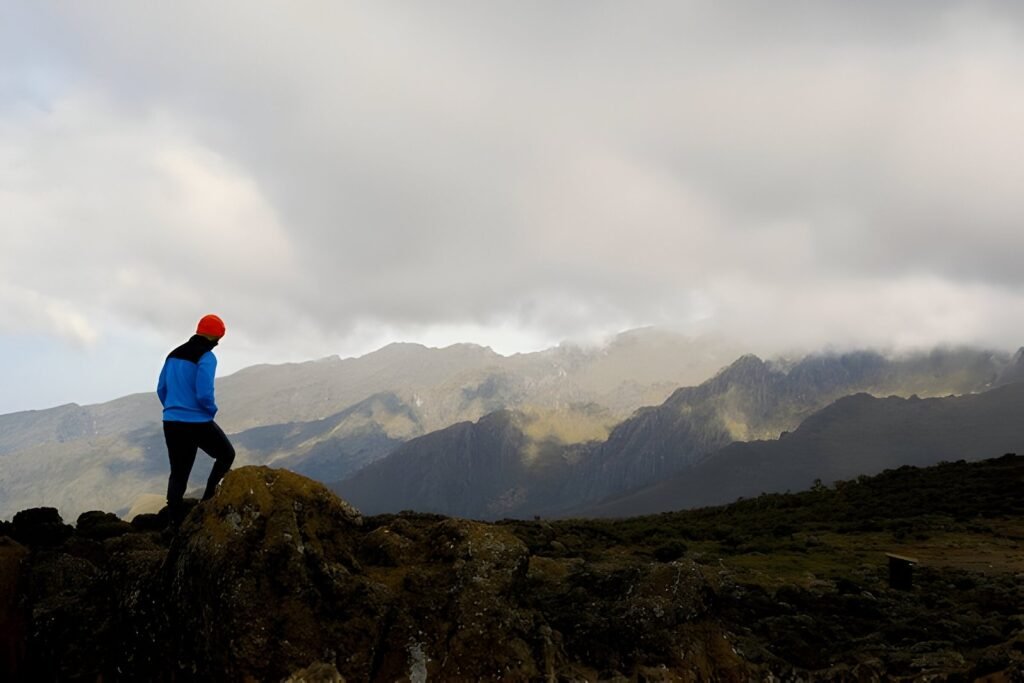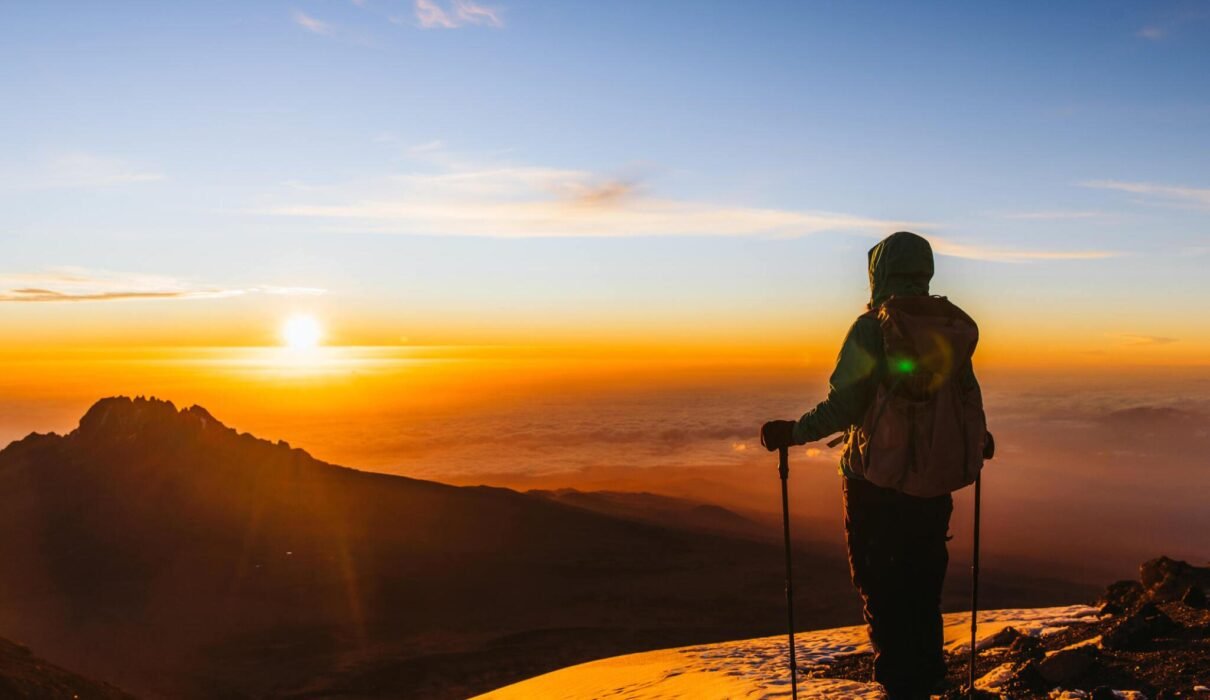Why We Recommend Crampons for Every Kilimanjaro : Climbing Mount Kilimanjaro is an incredible challenge and achievement for adventurers around the world. With its diverse weather conditions and high-altitude challenges, it’s essential to have the right equipment for a safe and comfortable trek. One of the most important pieces of gear we recommend for every Kilimanjaro trek is crampons. These traction devices provide added grip and stability, especially during the summit push, where icy and slippery conditions are common. In this guide, we’ll explain why crampons are essential, how they improve safety, and when they should be used during your Kilimanjaro trek
Find more expert gear tips for your Kilimanjaro climb here

Why We Recommend Crampons for Every Kilimanjaro : What Are Crampons and Why Are They Important for Kilimanjaro?
Crampons are metal spikes or cleats that attach to your hiking boots, providing extra traction on icy or snowy surfaces. While Kilimanjaro doesn’t require technical mountaineering gear for most of the trek, the final section, known as the Uhuru Peak summit push, often involves navigating through snow, ice, and loose gravel, particularly during colder months. Crampons are especially useful for maintaining balance and preventing slips, helping climbers stay safe in challenging conditions
- Benefits of Crampons: Increased stability, reduced risk of slips, and more confident footing on icy paths.
- When You’ll Need Them: Primarily during the summit attempt, especially on Stella Point and near the Uhuru Peak.
Learn more about how crampons improve safety in high-altitude climbs
Why We Recommend Crampons for Every Kilimanjaro : How Kilimanjaro’s Weather Impacts the Need for Crampons
The weather on Mount Kilimanjaro varies significantly as you ascend through its five distinct climate zones. By the time you reach the summit, the conditions can be unpredictable and harsh, with temperatures often dropping well below freezing. The upper slopes are commonly covered in snow and ice, especially between December and March and during the June to October dry season when overnight temperatures fall dramatically
Common Weather Conditions Near the Summit:
- Icy Trails: Temperatures can drop to -20°C (-4°F) at the summit.
- Loose Gravel and Scree: Unstable surfaces on the way to Stella Point.
- Snow and Ice: Especially near the Uhuru Peak and Crater Rim.
These conditions make crampons a critical addition to your Kilimanjaro gear. Check the best time to climb Kilimanjaro based on weather
Why We Recommend Crampons for Every Kilimanjaro : Which Kilimanjaro Routes Require Crampons?
Although crampons may not be necessary for the entirety of the climb, certain routes and sections demand their use more than others. The summit approach on Kilimanjaro tends to be where crampons become vital, regardless of which route you take.
Routes with Icy or Rocky Summit Sections:
- Machame Route (“Whiskey Route”): Known for its steep ascent to the summit, crampons provide extra grip during the final push.
- Lemosho Route: A scenic route with an extended acclimatization period, crampons are crucial near Stella Point.
- Rongai Route: Although a gentler route, icy conditions can still be encountered near the summit.
- Northern Circuit Route: Offers the longest acclimatization but includes icy patches near Uhuru Peak.
Explore the most challenging sections of each Kilimanjaro route here.
Why We Recommend Crampons for Every Kilimanjaro : Safety Benefits of Crampons: Reducing the Risk of Falls
The safety benefits of crampons go beyond just making it easier to walk on icy terrain. Falls and slips are some of the most common causes of injuries during high-altitude treks, especially in areas with snow and ice. Crampons provide additional traction and reduce the likelihood of losing your footing, giving you more confidence as you approach the summit.
- Improved Traction: Crampons grip the icy surface, making each step more secure.
- Enhanced Balance: Even in steep areas, crampons help maintain balance.
- Prevents Accidents: Less risk of falling means fewer injuries, which is crucial during the final summit push.
Learn more about the role of crampons in high-altitude safety
Why We Recommend Crampons for Every Kilimanjaro : When Should You Wear Crampons on Kilimanjaro?
Crampons are generally not required for the lower sections of the mountain, as most of the trails are well-trodden and free from ice. However, once you enter the Alpine Desert Zone (above 4,000 meters) and the final Arctic Zone, the use of crampons becomes increasingly important.
Key Sections for Crampon Use:
- Summit Night: From Barafu Camp (4,600m) to Uhuru Peak (5,895m), crampons will help you navigate the icy summit paths.
- Stella Point: Icy and windy conditions make crampons essential for stability.
- Crater Rim: The final push to the summit can involve ice and loose rocks, where crampons provide much-needed traction.
Discover more tips on preparing for Kilimanjaro’s summit here.
Why We Recommend Crampons for Every Kilimanjaro : Types of Crampons Suitable for Kilimanjaro Climbs
Not all crampons are the same, and for Kilimanjaro, you won’t need technical, mountaineering-grade crampons. Instead, lightweight, flexible crampons that can attach easily to regular hiking boots are ideal for the terrain you’ll face on the mountain.
Types of Crampons to Consider:
- Microspikes: These are smaller and lighter than traditional crampons, perfect for Kilimanjaro’s summit section.
- Hybrid Crampons: Designed to fit a variety of footwear, hybrids offer good grip on icy terrain.
- Aluminum Crampons: Lightweight and durable, they’re suitable for the less technical, icy conditions of Kilimanjaro
Check out different types of crampons and their uses here.
Why We Recommend Crampons for Every Kilimanjaro : Renting vs. Buying Crampons: What’s the Best Option?
For climbers considering whether to rent or buy crampons for their Kilimanjaro trek, both options have advantages. If you plan to use crampons only for this trip, renting might be more cost-effective. However, purchasing your own pair ensures the right fit, comfort, and familiarity during the climb.
Considerations:
- Renting: Available through many trekking companies and local outfitters.
- Buying: Allows you to test and break in the crampons before the trek, ensuring better comfort and reliability.
Get detailed advice on renting vs. buying climbing gear here.
Why We Recommend Crampons for Every Kilimanjaro : How to Fit and Use Crampons Properly
Wearing crampons correctly is crucial to ensure safety and comfort. Improperly fitted crampons can cause discomfort or even come loose during the ascent. Before the summit night, your guide will likely demonstrate how to attach and use crampons properly.
Steps for Proper Crampon Fitting:
- Secure the Straps: Ensure all straps are tightened evenly.
- Check the Fit: Walk a few steps to ensure the crampons feel secure and don’t shift.
- Practice Walking: Get used to walking with crampons in less challenging areas before heading to the summit.
Learn more about how to use crampons effectively on your Kilimanjaro trek.
Why We Recommend Crampons for Every Kilimanjaro : Other Essential Gear for Kilimanjaro Trekkers
Crampons aren’t the only piece of equipment you’ll need for a successful Kilimanjaro trek. Proper gear for different weather conditions and terrains is essential for a comfortable and safe climb.
Key Gear for Kilimanjaro:
- Layered Clothing: Moisture-wicking base layers, insulating mid-layers, and waterproof outerwear.
- Trekking Poles: Useful for maintaining balance, especially in snowy or uneven sections.
- Insulated Boots: Proper hiking boots with ankle support and insulation are critical for summit night.
Check out a complete gear checklist for Kilimanjaro here.
Expert Tips for Summit Success on Kilimanjaro
Reaching the summit of Kilimanjaro is a physical and mental challenge, but with the right preparation and gear, including crampons, it’s within reach. Here are a few final expert tips to ensure you succeed:
- Pace Yourself: Take your time to acclimatize and avoid rushing, especially on summit night.
- Stay Hydrated: Drink plenty of water, even in the cold, to stay energized.
- Trust Your Guide: Follow the advice of your Kilimanjaro guide—they know the mountain best.
Find more tips for summit success on Kilimanjaro here.

Why We Recommend Crampons for Every Kilimanjaro : Conclusion
Crampons are a crucial tool for ensuring a safe and successful Kilimanjaro summit. While not required for the entire trek, they make a significant difference during the final, icy push to the top. By understanding how to use them and choosing the right type for your trek, you’ll increase your chances of reaching Uhuru Peak safely and comfortably
For more information on preparing for your Kilimanjaro adventure, visit Kilimanjaro Climb Specialist or Eddy Tours & Safaris

